The food groups offer us many opportunities to enjoy iron-rich foods throughout the day, with every meal. However, the different food groups play their own role in iron metabolism, making an iron rich foods list more nuanced than you would expect.
Meats
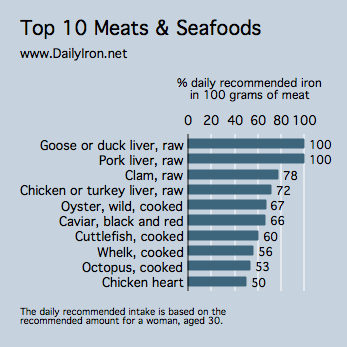 Meats are one of the few food types without iron inhibitors. Meat, particularly red meat, also tends to be very high in iron. We present the top meats in the figure at right. Note that if you are pregnant, liver is quite high in vitamin A and unless you have a known vitamin A deficiency, you can consume too much vitamin A in a pregnancy diet and that fat-soluble vitamin can be harmful to the baby. Read more about iron in meat.
Meats are one of the few food types without iron inhibitors. Meat, particularly red meat, also tends to be very high in iron. We present the top meats in the figure at right. Note that if you are pregnant, liver is quite high in vitamin A and unless you have a known vitamin A deficiency, you can consume too much vitamin A in a pregnancy diet and that fat-soluble vitamin can be harmful to the baby. Read more about iron in meat.
Grains
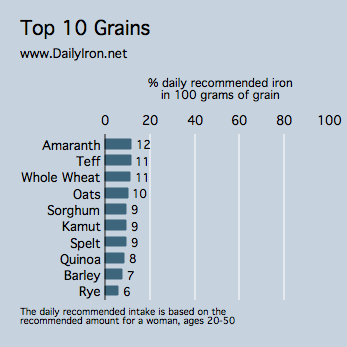 Grains can be great sources of iron, but they do have a powerful iron inhibitor called phytic acid which does decrease your absorption of iron. For the most part, the bran of the grain will have a higher content of iron (and of phytic acid). In addition, some alternative grains such as amaranth, teff, and quinoa are very good options. If you rely on grains (and beans) for iron, you must take measures in preparing your food to reduce the phytic acid content. Read more about our tips and tricks to improve your digestion of iron from grains.
Grains can be great sources of iron, but they do have a powerful iron inhibitor called phytic acid which does decrease your absorption of iron. For the most part, the bran of the grain will have a higher content of iron (and of phytic acid). In addition, some alternative grains such as amaranth, teff, and quinoa are very good options. If you rely on grains (and beans) for iron, you must take measures in preparing your food to reduce the phytic acid content. Read more about our tips and tricks to improve your digestion of iron from grains.
Beans
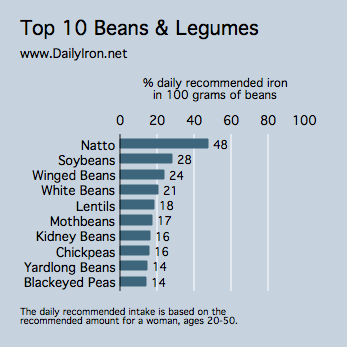 Like grains, beans can be great sources of iron if they are prepared properly. They contain phytic acid which blocks your uptake of iron, but that phytic acid can be reduced by soaking your beans overnight in very warm water before you cook them. Soybeans top the iron-rich list, but we should warn you that soybeans are very high in phytic acid and, in fact, the phytic acid is difficult to remove. You really need to consume fermented soy such as tempeh and miso to benefit from the iron content. Read our tips and tricks page for more on these iron rich foods.
Like grains, beans can be great sources of iron if they are prepared properly. They contain phytic acid which blocks your uptake of iron, but that phytic acid can be reduced by soaking your beans overnight in very warm water before you cook them. Soybeans top the iron-rich list, but we should warn you that soybeans are very high in phytic acid and, in fact, the phytic acid is difficult to remove. You really need to consume fermented soy such as tempeh and miso to benefit from the iron content. Read our tips and tricks page for more on these iron rich foods.
Nuts and Seeds
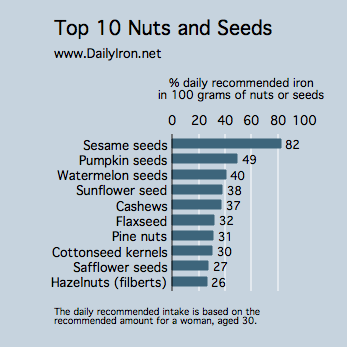 Nuts and seeds also contain phytic acid which does reduce your absorption of iron. We do recommend soaking them to reduce the phytic acid content but soaking is not as effective as we might hope. It is probably best to rely on a combination of food for iron, not just on nuts and seeds. However, soaking sesame seeds and sunflower seeds and adding them liberally to your recipes could be a great strategy. Increasingly, artisan sourdough breads are available that make use of nuts and seeds. These are also good options.
Nuts and seeds also contain phytic acid which does reduce your absorption of iron. We do recommend soaking them to reduce the phytic acid content but soaking is not as effective as we might hope. It is probably best to rely on a combination of food for iron, not just on nuts and seeds. However, soaking sesame seeds and sunflower seeds and adding them liberally to your recipes could be a great strategy. Increasingly, artisan sourdough breads are available that make use of nuts and seeds. These are also good options.
Vegetables
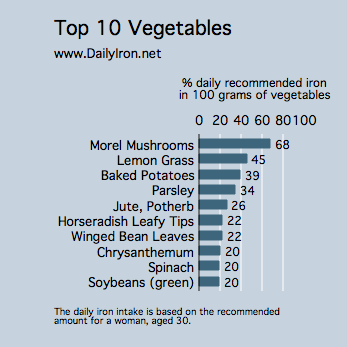 Vegetables as a class are generally a poor source of iron; there really are no iron rich vegetables. Furthermore, if you eat your vegetables with iron inhibitors such as those common in grains and beans, you will likely not benefit from the iron in vegetables at all. To get the most out of your vegetables, explore the resources on this site about reducing iron inhibitors, particularly our tips and tricks page.
Vegetables as a class are generally a poor source of iron; there really are no iron rich vegetables. Furthermore, if you eat your vegetables with iron inhibitors such as those common in grains and beans, you will likely not benefit from the iron in vegetables at all. To get the most out of your vegetables, explore the resources on this site about reducing iron inhibitors, particularly our tips and tricks page.
Fruits
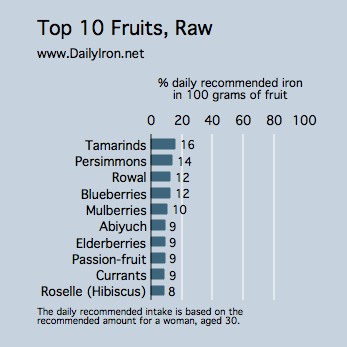 Like vegetables, there really are no iron rich fruits, but fruits with their high vitamin C content can play an important role in iron metabolism for people who do not have large amounts of iron in their diet. In the case of fruit, your best bet for iron metabolism is to focus on fruit high in vitamin C such as citrus fruit or tomato.
Like vegetables, there really are no iron rich fruits, but fruits with their high vitamin C content can play an important role in iron metabolism for people who do not have large amounts of iron in their diet. In the case of fruit, your best bet for iron metabolism is to focus on fruit high in vitamin C such as citrus fruit or tomato.
Examine these food groups and create your own iron rich foods list that will work for you in your own kitchen and meet your family’s own needs.